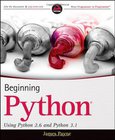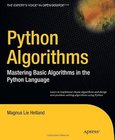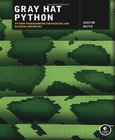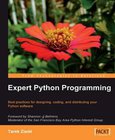Python
Create - Modify - Reuse
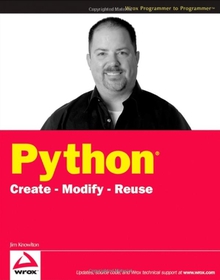
Book Details:
| Publisher: | Wrox |
| Series: | Wrox |
| Author: | Jim Knowlton |
| Edition: | 1 |
| ISBN-10: | 0470259329 |
| ISBN-13: | 9780470259320 |
| Pages: | 262 |
| Published: | Jul 08 2008 |
| Posted: | Nov 19 2014 |
| Language: | English |
| Book format: | |
| Book size: | 6.29 MB |
Book Description:
Python: Create-Modify-Reuse is designed for all levels of Python developers interested in a practical, hands-on way of learning Python development. This book is designed to show you how to use Python (in combination with the raw processing power of your computer) to accomplish real-world tasks in a more efficient way. Don't look for an exhaustive description of the Python languageyou won't find it. The book's main purpose is not to thoroughly cover the Python language, but rather to show how you can use Python to create robust, real-world applications.This book is for developers with some experience with Python who want to explore how to develop full-blown applications. It is also for developers with experience in other languages who want to learn Python by building robust applications. It is well-suited for developers who like to 'learn by doing,' rather than exploring a language feature by feature. To get the most out of the book, you should understand basic programming principles.This book starts with a basic overview of the Python language, designed for those familiar with other languages but new to Python. It is followed by several chapters, each of which describes a complete project that can be used as-is or modified and extended to suit your particular purposes. You'll find applications that access databases, take advantage of web technologies, and facilitate network communications, to name a few. In addition, and more important than the technologies you will be introduced to, you will learn how to use Python to solve real challenges. Following these chapters are two chapters that cover accessing operating system resources and debugging and testing, respectively.This book is framed around the code itself. This is because developers are typically looking for how to do something; and, as with many activities, you learn how to do something by watching how others do and trying it yourself. If you want to know how a for loop works, you'll find for loops in my code, but that's not the thrust of the book. Instead, this book shows you how to do things: how to build a content management system, how to build a test management system, how to set up a system for tracking customer follow-up, and so on. Along the way, you'll learn how to communicate with a SQL database, how to act as a web server or communicate with one, how to access operating system services, and more.
Book categories:
Programming , Web Development , Languages & Tools , Programming Languages , Software Design, Testing & Engineering , Object-Oriented Design , Web Design , Software Reuse , PythonDownload Link:
Related Books:
Beginning Python
Using Python 2.6 and Python 3.1
Beginning Python: Using Python 2.6 and Python 3.1 introduces this open source, portable, interpreted, object-oriented programming language that combines remarkable power with clear syntax. This book enables you to quickly create robust, reliable, and reusable Python applications by teaching the basics so you can quickly develop Web and scientific applications, incorporate databases, and master systems tasks on various operating systems, including Linux, MAC OS, and Windows. You'll get a comprehensive tutorial that guides you from writing simple, basic Python scripts all the way through complex concepts, and also features a reference of the standard modules with examples illustrating how to implement features in the various modules. Plus, the book cov...
Python Algorithms
Mastering Basic Algorithms in the Python Language
Python Algorithms explains the Python approach to algorithm analysis and design. Written by Magnus Lie Hetland, author of Beginning Python,this bookis sharply focused on classical algorithms, but it also gives a solid understanding of fundamental algorithmic problem-solving techniques. The book deals with some of the most important and challenging areas of programming and computer science, but in a highly pedagogic and readable manner. The book covers both algorithmic theory and programming practice, demonstrating how theory is reflected in real Python programs. Well-known algorithms and data structures that are built into the Python language are explained, and the user is shown how to implement and evaluate others himself. What youll learn Tra...
Gray Hat Python
Python Programming for Hackers and Reverse Engineers
Python is fast becoming the programming language of choice for hackers, reverse engineers, and software testers because it's easy to write quickly, and it has the low-level support and libraries that make hackers happy. But until now, there has been no real manual on how to use Python for a variety of hacking tasks. You had to dig through forum posts and man pages, endlessly tweaking your own code to get everything working. Not anymore.Gray Hat Python explains the concepts behind hacking tools and techniques like debuggers, trojans, fuzzers, and emulators. But author Justin Seitz goes beyond theory, showing you how to harness existing Python-based security tools - and how to build your own when the pre-built ones won't cut it.You'll learn how to: Aut...
Expert Python Programming
Best practices for designing, coding, and distributing your Python software
Expert Python Programming shows how Python development should be done with best practices and expert design tips. This book is for Python developers who are already building applications, but want to build better ones by applying best practices and new development techniques to their projects. The reader is expected to have a sound background in Python programming....
2007 - 2021 © eBooks-IT.org

